History
The stock trading floor has attracted attention as a symbol of the securities and financial markets of our country for more than 120 years since floor trading began at the former Tokyo Stock Exchange, the predecessor of the current Tokyo Stock Exchange, on June 1, 1878.
However, the stock trading floor was closed on April 30, 1999 in an effort to accelerate the speed and reduce the cost of transactions by member securities companies, and seek further efficiency in the Tokyo market.
At the site of the stock trading floor, "TSE arrows" was opened on May 9, 2000 as a new symbol of the Tokyo market.
This page introduces the history of the stock trading floor along with some pictures.
Opening of the former Tokyo Stock Exchange to the early Showa era
Appearance of the former Tokyo Stock Exchange at the time of its foundation
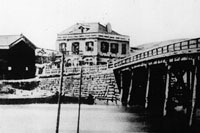
The former Tokyo Stock Exchange, which was the predecessor of the current Tokyo Stock Exchange, was founded. (May, 1878)
Floor trading at the former Tokyo Stock Exchange in the early Meiji era
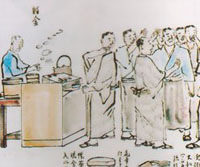
In the early Meiji era, floor clerks worked in kimono. (In the 1880s)
Floor trading at the former Tokyo Stock Exchange in the middle of the Meiji era
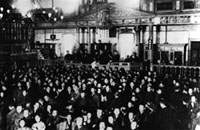
In the middle of the Meiji era, the stock trading floor was renewed as the scale of the market expanded. The most actively traded stock was the former Tokyo Stock Exchange's stock. (In the 1890s)
Floor trading at the former Tokyo Stock Exchange in the early Showa era
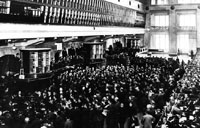
In the early Showa era, a great deal of government bonds were issued during wartime. (In the 1930s)
Opening of the Japan Securities Exchange to opening of the current Tokyo Stock Exchange
Opening ceremony of Japan Securities Exchange
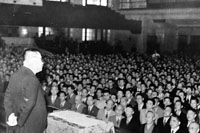
11 exchanges across the country were merged into the Japan Securities Exchange with the former Tokyo Stock Exchange's stock incorporated into the controlled economy during wartime. (March, 1943)
Dome under the control of General Headquarters of the Allied Forces (GHQ)
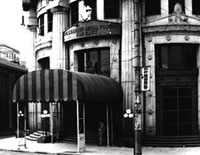
Floor trading was suspended in August 1945 with aggravation of the war situation. After the war ended, the stock trading floor was occupied by the GHQ until January 1948. (Around 1946)
Floor trading at the time of reopening of Tokyo Stock Exchange
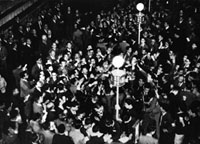
The Japan Securities Exchange was dissolved in 1947 while a large number of shares were reallocated to public investors due to a breakup of Japanese "Zaibatsu" conglomerates. Possessing stocks immediately became popular with securities privatization and promotions. Trading at the Tokyo Stock Exchange resumed in May, 1949. (May, 1949)
Placing trading posts at the time of opening of Tokyo Stock Exchange
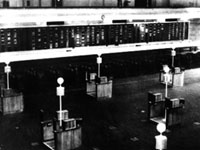
12 U-shaped trading posts were placed at the time of opening of Tokyo Stock Exchange. (May 1949)
1959 to the end of the former stock trading floor
Black Boards at the stock trading floor
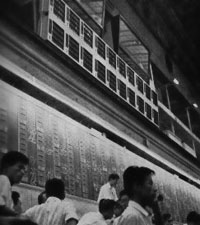
Prices of transactions were written on the black board with chalk. (1959)
Floor trading in the 1960s
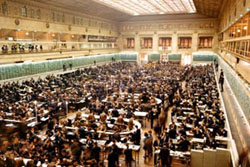
In the 1960s, the securities industry suffered from the heaviest blow in the postwar era due to the slumping economy and sluggish stock and investment trust trading. In January 1968, the regulatory frameworks of securities companies were shifted to a licensing system. (In 1969)
Floor trading when the market price information system began operations
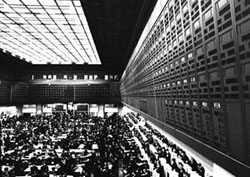
The prices of stocks were displayed on the electronic signboard when the market information system began operating at the stock trading floor. (September, 1974)
GEKITAKU (clappers which were beaten when transactions were executed)
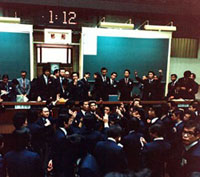
GEKITAKU trading, group competitive call auction trading started in the middle of the era where stocks issued by Tokyo Stock Exchange were traded in December 1900, and continued until December 1982. (In the 1980s)
Floor trading in the 1980s
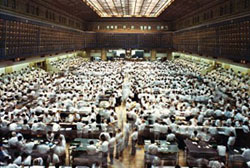
The former stock trading floor in the 1980s is shown to the right.
Opening of the new stock trading floor to its closing
Opening ceremony of the new stock trading floor
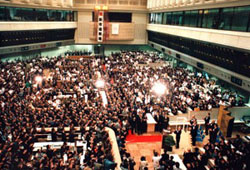
Upon the completion of the new stock trading floor building, the floor was opened on the site of the former main building. (May 1985)
Floor trading at the new stock trading floor (1)
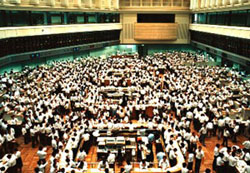
A boom in stocks started around 1985 when the new stock trading floor was opened. (In the latter half of the 1980s)
Floor trading at the new stock trading floor (2): Introduction of a system to streamline operations at stock trading floor(November, 1990)
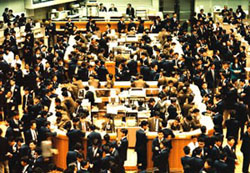
TSE computerized relevant operations at the stock trading floor, such as placing and matching orders, which had been done manually. With the computerization of the operations, placing orders on-line became possible also for stocks traded in the stock trading floor if the order was a small lot (less than specific volume), which resulted in accelerating computerization of relevant operations at the stock trading floor.
Floor trading at the new stock trading floor (3)
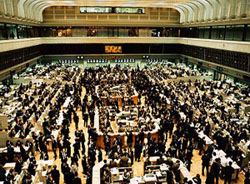
Accelerating the computerization gradually reduced the number of clerks on the stock trading floor. (Mid-1990s)
Last closing session of the year on the stock trading floor
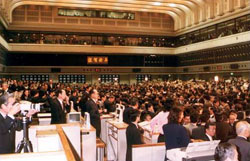
The last closing session of the year on the stock trading floor is shown to the left. A large number of people involved in the securities industry packed the stock trading floor, reminiscing about the old days and hoping to make a life-long memory. (On December 30, 1998)
Last opening session of the year on the stock trading floor
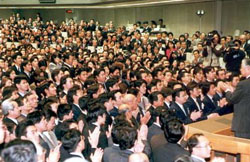
The last opening session of the year on the stock trading floor is shown to the right. This is the last look at employees in kimono, which was the established custom of Tokyo Stock Exchange. (January 4, 1999)



